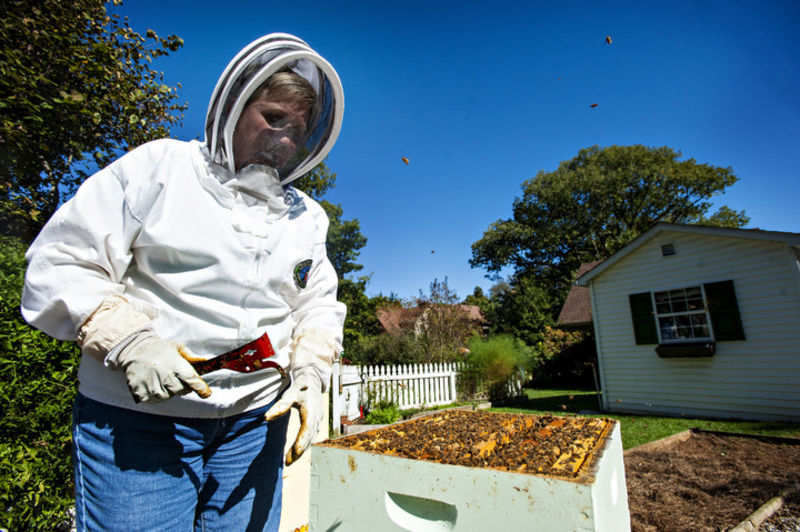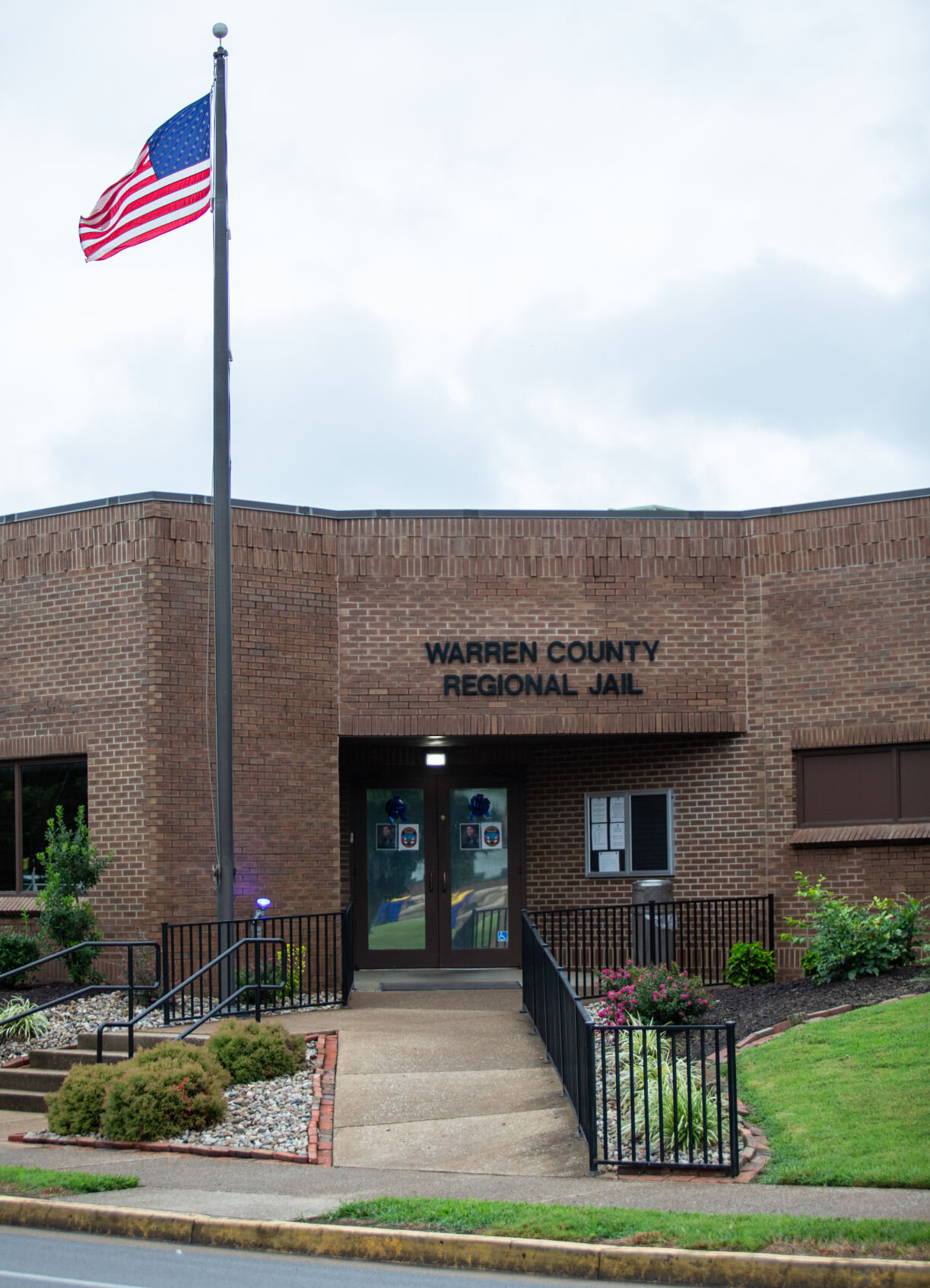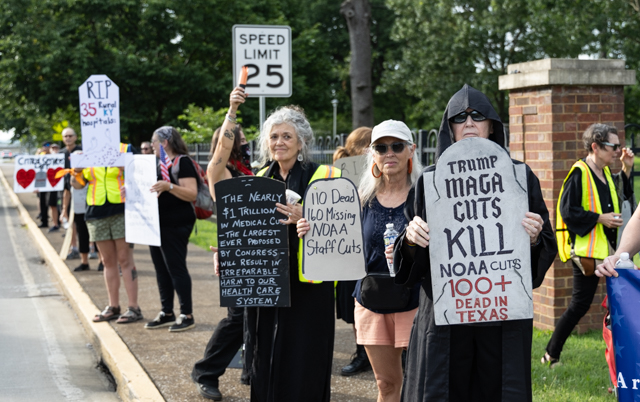Hobbyists face large demand for local honey
Published 1:00 am Sunday, October 12, 2014

- Michele Boling wears protective covering as she checks on one of three of her bee hives Wednesday, Oct. 8, 2014, at her Bowling Green home. Boling is among an "explosion" of hobbyist beekeepers that Kentucky State Apiarist Tammy Horn has seen in recent years. (Miranda Pederson/Daily News)
A blanket of bees paid little attention Wednesday to Michele Boling as she opened their hive and pulled out a thin wooden frame to examine the contents of tiny hexagons of beeswax.
Some were filled with glistening honey, and others had been capped with wax, indicating they were full.
Trending
Boling was checking to see how far along the hive was in storing honey for the winter. She said she would have preferred to see more of the honeycomb capped.
But Boling’s bees were busy collecting provisions that sunny afternoon, swooping into the small opening at the front of a green hive painted with flowers.
She also provides them with sugar water in a glass jar placed near the top of the hive this time of year to make sure they have enough material to make honey for the winter.
With three beehives in her backyard in Bowling Green, Boling is among an “explosion” of hobbyist beekeepers that Kentucky State Apiarist Tammy Horn has seen in recent years.
That rise in hobbyists has coincided with a leveling off in the number of commercial beekeepers, she said.
There are fewer than 2,000 commercial beekeepers in the United States, Horn said.
Trending
Factors in that trend include a lack of support and security in the beekeeping profession, she said. Commercial beekeepers tend to be those who will rent hives to pollinate crops, and that means the beekeepers spend a lot of time on the road.
One of Horn’s roles as state apiarist is to perform health assessments on hives coming into the state.
“If bees are coming into the state, we want to make sure that they’re healthy,” Horn said.
Factors including increased attention on beekeeping with the rise of colony collapse disorder and a rise in interest in locally produced food and gardening have led to an increase in the number of hobbyist beekeepers, she said.
One of Horn’s goals is to give hobbyist beekeepers more confidence to sell their products to fill in a shortage of honey and beeswax, she said.
“There’s a saying in the beekeeping world that you’ll be a beginner for 20 years,” she said.
There were about 3,000 honey-producing bee colonies in Kentucky in 2013. Kentucky producers with five or more colonies produced about 123,000 pounds of honey, according to the latest report from the U.S. Department of Agriculture.
That’s down from about 5,000 honey-producing colonies in 2012. Producers with five or more colonies produced about 255,000 pounds of honey that year, according to the report.
There’s a large demand for local honey, and there isn’t enough honey to fill the demand, according to Megan Bailey, Warren County Extension agent for horticulture.
The local food movement has boosted that demand, she said.
“People want to be able to support our local farmers and local producers,” Bailey said.
There is also a health aspect to eating local honey because it’s a natural sugar, she said.
Boling got her first beehive in the spring of 2012 after a friend who was a beekeeper invited Boling and another friend to see her hives.
She said she found the experience intriguing. Boling’s father was a biology professor at Western Kentucky University, so she had some experience with insects.
“The prospect of boxes full of bugs wasn’t that daunting to me,” she said.
In the past two years, beekeeping has become more than just a hobby, Boling said. It is a passion. “It’s one of those things, there’s no lukewarm to it,” she said.
Boling has two of her hives set up in a garden area where she said she often likes to sit and just watch them move in and out of the hive.
Healthy respect
She has a respect for the ways that bees live, with everything they do focused on the colony, Boling said. That’s true to the point that a sick bee often won’t return to its hive.
“I wish people were more like bees sometimes,” she said.
Beekeepers also tend to have a respect for the honey their bees produce, Boling said. Each bee will produce only about half a teaspoon of honey in its life.
Boling started out with one hive and got another last year. This year, however, one of her hives swarmed, which means that the queen and about half of the existing bees left the colony to find another place to live.
The bees form a compact swarm to protect the queen and will land somewhere such as in a tree or a bush.
Boling was able to capture her swarm and establish a new hive with the help of a beekeeping mentor.
While swarms can be intimidating, bees tend to be docile when they swarm because they gorge themselves with honey for the trip before swarming, she said.
Boling recommends that people not try to deal with swarms by using pesticides, but instead contact a beekeeper.
They are usually willing to come out to collect a swarm because to beekeepers, swarms represent “free bees,” she said.
Boling usually wears protective gear including a white jacket with a connected mesh hood and gloves when she works with her bees. Some beekeepers forgo gloves, but Boling said she’s not to the point where she’s comfortable doing that.
She said she sees her bees as a mix between having a pet and taking part in an agricultural endeavor.
While she isn’t afraid of the bees, she said she respects them. There are days when Boling said she opens up a hive to do an inspection but can tell they are not in the mood, and will close up the hive and leave them alone.
“Any beekeeper who doesn’t wear a veil is just plain old crazy,” Boling said.
Harris Overholt, who lives in the Chapel Hill area of Allen County, has been keeping bees for about 20 years. He started out just helping a cousin with his bees but now has 35 hives.
Though Kentucky hives usually produce about 60 pounds of honey for harvest per hive, this year has been a good one and he got about 100 pounds per colony, he said.
The type of honey he harvests will depend upon what was blooming when the bees were collecting pollen and nectar, Overholt said.
Tulip poplars bloom in May, and the honey produced when bees are collecting nectar from those blooms is a dark amber color with a sorghum flavor, he said. A lighter colored honey is produced when bees have collected clover in June.
Overholt sells his honey at a couple of small stores and also rents out hives for pollination.
He said his honey sales have been strong.
“Really, I can’t supply the market,” Overholt said.
While there are natural pollinators such as bumblebees, wasps, flies and wild honeybees, when farmers raise many acres of a crop, natural pollinators can be overwhelmed, he said.
Having honeybees pollinating a crop can increase yield by 30 to 40 percent, Overholt said.
Overholt also produces pollen, which is the source of protein in a bee’s diet, but also can be used as a dietary supplement.
John Hepner of Warren County has been beekeeping for about eight years and has 15 hives at two different locations.
Both his father and grandfather were beekeepers, he said.
Bee sociology
“I have always just been fascinated by bee sociology,” he said.
A colony of bees works together for the good of the colony, Hepner said.
“There’s just so many things that happen within the hive in their own little world there,” he said.
The biggest challenge to keeping bees is that there are a lot of things now that can be detrimental to their health, Hepner said.
The change in the rural environment in the past 25 to 35 years has meant a reduction in foraging opportunities for bees and a rise in the chemicals used in agriculture, he said.
Pests, such as the varroa mite, can also weaken hives, Hepner said.
Research suggests colony collapse disorder might be caused by a “perfect storm” of factors such as those, he said.
Colony collapse disorder is when beekeepers see a large loss in the number of bees in their hives. It is characterized by low presence of adult honeybees in a hive but with a lack of dead honeybee bodies, according to the USDA website. Often a queen is still present along with immature bees.
Hepner sells comb honey by the jar and chunk honey, which includes just the comb with honey still in it, at the SKY Farmers Market.
Think tomato from the vine
He said the difference between local honey and store-bought honey is like the difference in taste between a tomato from the vine in July and a tomato from a grocery in January.
“The people that understand that difference seek out the local raw honey,” he said.
Some people also think that eating local honey can provide a medicinal benefit by helping them build up a tolerance to local pollen and therefore reducing allergy symptoms because pollen granules are present in locally produced honey, Hepner said.
He said about 75 percent of people who approach him about buying honey are using it for allergy control.
Hepner, Overholt and Boling all suggested that anyone interested in beekeeping should contact a local beekeeping association, such as those in Warren or Allen counties, and seek out a mentor who has experience in the field.
The Kentucky State Beekeepers Association will hold its fall meeting in Bowling Green from 9 a.m. to 3 p.m. Nov. 8 at the Warren County Cooperative Extension building. The extension office will host a beginning beekeeping class starting Dec. 1 and running through the beekeeping season, Bailey said. The fee for the class is $50. Those interested can call the cooperative extension office at 270-842-1681.
The Allen County Beekeepers Association website has a calendar of beekeeping association meetings and contact information for beekeepers for the public who encounter swarms or need pollination or bee removal services. That website can be found at sites.google.com/site/allencountybeekeepers/.
— Follow reporter Katie Brandenburg at twitter.com/BGDNgovtbeat or visit bgdailynews.com.






